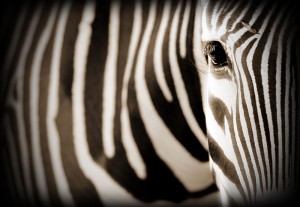THURSDAY, 29 MARCH 2012
Existing theories as to why zebras have evolved stripes centre on their role in combating predators. Stripes may provide camouflage in the long grass and dappled shade of the savannah; they may also confuse predators by breaking up the outline of the zebra within a herd, making it hard for predators to tell where one individual ends and another begins. However, new research by Hungarian and Swedish scientists suggests that stripes may additionally have evolved to confuse a smaller type of creature – bloodsucking horseflies.Horseflies cause nasty bites and can transmit blood-borne diseases. They are attracted to horizontally polarised light because it resembles the light reflected off water sources, signalling a good place to mate and lay eggs. Black horses reflect more polarised light than brown horses, which in turn reflect more than white horses. Researchers therefore expected that zebras, with their black and white stripes, would be of intermediate attractiveness to horseflies.
To test this theory, the scientists placed sticky black, brown, white and zebra-striped boards and 3D models in a field and counted the number of horseflies that became stuck. Surprisingly, the zebra-striped ones caught the least number of horseflies, and the narrower and more numerous the stripes, the better. Moreover, the least attractive patterns were very similar to the polarisation and striping patterns of real zebras. It’s thought that the stripes break up the dark coat, creating a mix of polarised and unpolarised light, which confuses the horseflies. This may also explain why the thinnest (and most effective) stripes are found on the zebra’s face and legs, which are the most vulnerable areas of skin.
However, this may not be the whole story. Even if the stripes do confuse horseflies, there are other cues that flies can use to detect the zebra such as heat or the sound of breathing. Further comparisons using live animals in their native setting are now required. It’s likely that the zebra’s stripes evolved due to a combination of advantages, involving the confusion of predators as well as pests.
Written by Zoё Li
doi:10.1242/jeb.065540

